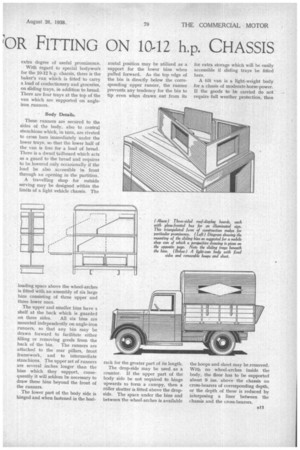SPECIAL BODYWORK SUITABLE
Page 46

Page 47

If you've noticed an error in this article please click here to report it so we can fix it.
'OR FITTING ON 10-12 h.p. CHASSIS
THE standardized types of light delivery van mounted on 10-12 h.p. chassis are used in a wide variety of trades and usually the van, as purchased, suits the requirements of the operator. In other instances the body is slightly modified, or special equipment is added owing to the particular needs of the user concerned.
If a butcher buys a light van for market work, in addition to his larger vehicles, he may require more headroom than the standard body provides. The panels are removed so that the roof may be lifted and the sides and ends of the loading portions extended upwards 10 or 12 ins. Similar modifications are made for laundrymen and commercial travellers.
Carrying Neon Signs.
The van of the neon signmaker has not only to be adapted for carrying ladders, but the lettering and other parts made of glass tubing which must be specially protected from vibration during transit.
A large van or lorry is designed to carry the neon signwork inside, but with a smaller vehicle it will be more convenient to carry the glass lettering on the roof. In either case a similar device is used, that is a wooden frame which has a base of interlaced webbing similar to the foundation of an upholstered chair.
If ladders, as well as signwork, are to be carried on the roof, then the webbed frame is high enough so that cross rails for supporting a set of ladders may be arranged under it.
The owner of a light delivery van
a12 may wish to increase the publicity value of his vehicle so the roof is surrounded with boarding to increase the area for writing display.
As an instance of this, deep boarding is specified to provide ample space for the announcements' concerned. The facia may consist of boards battened together, or a framework is covered with an aluminium panel. Again, the owner may wish to include illuminated signs. To reduce the wind resistance of high boarding, the superstructure is triangularshaped in plan and there is a box with a glazed front and removable back on all three sides. The two sides which meet at a point in front, being set at an angle with the longitudinal axis of the vehicle, have an
extra degree of useful prominence.
With regard to special bodywork for the 10-12 h.p. chassis, there is the baker's van which is fitted to carry a load of confectionery and groceries, on sliding trays, in addition to bread. There are four trays at the top of the van which are supported on angleiron runners.
Body Details.
These runners are secured to the sides of the body, also to central stanchions which, in turn, are riveted to cross bars immediately under the lower trays, so that the lower half of the van is free for a load of bread. There is a dwarf tailboard which acts as a guard to the bread and requires to be lowered only occasionally if the load be also accessible in front through an opening in the partition.
A travelling shop for outside serving may be designed within the limits of a light vehicle chassis. The loading space above the wheel-arches is fitted with an assembly of six large bins consisting of three upper and three lower ones.
The upper and smaller bins have a shelf at the back which is guarded on three sides. All six bins are mounted independently on angle-iron runners, so that any bin may be drawn forward to facilitate either filling or removing goods from the back of the bin. The runners are attached to the rear pillars, front framework, and to intermediate stanchions. The upper set of runners are several inches longer than the bins which they suppprt, consequently it will seldom be necessary to draw these bins beyond the front of the runners.
The lower part of the body side is hinged and when fastened in the hori
zontal position may be utilized as a support for the lower bins when pulled forward. As the top edge of the bin is directly below the corresponding upper runner, the runner prevents any tendency for the bin to tip even when drawn out from its rack for the greater part of its length.
The drop-side may be used as a counter. If the upper part of the body side be not required to hinge upwards to form a canopy, then a roller shutter is fitted above the dropside. The space under the bins and between the wheel-arches is available for extra storage which will be easily accessible if sliding trays be fitted here.
A tilt van is a light-weight body for a chasis of moderate horse-power. If the goods to be carried do not require full weather protection, then the hoops and sheet may be removed. With no wheel-arches inside the body, the floor has to be supported about 9 ins, above the chassis on cross-bearers of corresponding depth, or the depth of these is reduced by interposing a liner between the chassis and the cross-bearers.




















































































